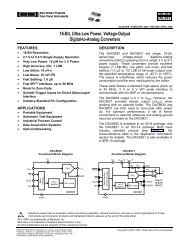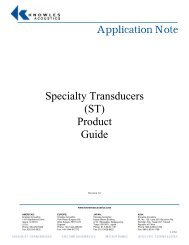DAC8532: Dual-Channel, Low-Power, 16-Bit, Serial-Input ... - dreamm
DAC8532: Dual-Channel, Low-Power, 16-Bit, Serial-Input ... - dreamm
DAC8532: Dual-Channel, Low-Power, 16-Bit, Serial-Input ... - dreamm
You also want an ePaper? Increase the reach of your titles
YUMPU automatically turns print PDFs into web optimized ePapers that Google loves.
MICROPROCESSOR<br />
INTERFACING<br />
<strong>DAC8532</strong> to 8051 INTERFACE<br />
Figure 6 shows a serial interface between the <strong>DAC8532</strong> and<br />
a typical 8051-type microcontroller. The setup for the interface<br />
is as follows: TXD of the 8051 drives SCLK of the<br />
<strong>DAC8532</strong>, while RXD drives the serial data line of the device.<br />
The SYNC signal is derived from a bit-programmable pin on<br />
the port of the 8051. In this case, port line P3.3 is used. When<br />
data is to be transmitted to the <strong>DAC8532</strong>, P3.3 is taken LOW.<br />
The 8051 transmits data in 8-bit bytes; thus only eight falling<br />
clock edges occur in the transmit cycle. To load data to the<br />
DAC, P3.3 is left LOW after the first eight bits are transmitted,<br />
then a second and third write cycle is initiated to transmit the<br />
remaining data. P3.3 is taken HIGH following the completion<br />
of the third write cycle. The 8051 outputs the serial data in a<br />
format which presents the LSB first, while the <strong>DAC8532</strong><br />
requires its data with the MSB as the first bit received. The<br />
8051 transmit routine must therefore take this into account,<br />
and “mirror” the data as needed.<br />
80C51/80L51 (1)<br />
P3.3<br />
TXD<br />
RXD<br />
NOTE: (1) Additional pins omitted for clarity.<br />
<strong>DAC8532</strong> (1)<br />
SYNC<br />
SCLK<br />
D IN<br />
68HC11 (1) PC7<br />
SCK<br />
MOSI<br />
NOTE: (1) Additional pins omitted for clarity.<br />
FIGURE 8. <strong>DAC8532</strong> to 68HC11 Interface.<br />
<strong>DAC8532</strong> (1)<br />
SYNC<br />
SCLK<br />
D IN<br />
The 68HC11 should be configured so that its CPOL bit is 0<br />
and its CPHA bit is 1. This configuration causes data appearing<br />
on the MOSI output to be valid on the falling edge of SCK.<br />
When data is being transmitted to the DAC, the SYNC line is<br />
held LOW (PC7). <strong>Serial</strong> data from the 68HC11 is transmitted<br />
in 8-bit bytes with only eight falling clock edges occurring in<br />
the transmit cycle. (Data is transmitted MSB first.) In order to<br />
load data to the <strong>DAC8532</strong>, PC7 is left LOW after the first<br />
eight bits are transferred, then a second and third serial write<br />
operation is performed to the DAC. PC7 is taken HIGH at the<br />
end of this procedure.<br />
<strong>DAC8532</strong> to TMS320 DSP INTERFACE<br />
Figure 9 shows the connections between the <strong>DAC8532</strong> and<br />
a TMS320 digital signal processor. By decoding the FSX<br />
signal, multiple <strong>DAC8532</strong>s can be connected to a single<br />
serial port of the DSP.<br />
FIGURE 6. <strong>DAC8532</strong> to 80C51/80L51 Interface.<br />
<strong>DAC8532</strong> to Microwire INTERFACE<br />
Figure 7 shows an interface between the <strong>DAC8532</strong> and any<br />
Microwire compatible device. <strong>Serial</strong> data is shifted out on the<br />
falling edge of the serial clock and is clocked into the<br />
<strong>DAC8532</strong> on the rising edge of the SK signal.<br />
TMS320 DSP<br />
FSX<br />
DX<br />
<strong>DAC8532</strong><br />
V DD<br />
Positive Supply<br />
0.1µF 10µF<br />
Output A<br />
Output B<br />
Microwire TM CS<br />
<strong>DAC8532</strong> (1)<br />
SYNC<br />
CLKX<br />
SYNC<br />
V OUT A<br />
D IN<br />
V OUT B<br />
SCLK<br />
V REF<br />
GND<br />
0.1µF 1µF to 10µF<br />
Reference<br />
<strong>Input</strong><br />
SK<br />
SO<br />
NOTE: (1) Additional pins omitted for clarity.<br />
FIGURE 7. <strong>DAC8532</strong> to Microwire Interface.<br />
SCLK<br />
<strong>DAC8532</strong> to 68HC11 INTERFACE<br />
Figure 8 shows a serial interface between the <strong>DAC8532</strong> and<br />
the 68HC11 microcontroller. SCK of the 68HC11 drives the<br />
SCLK of the <strong>DAC8532</strong>, while the MOSI output drives the<br />
serial data line of the DAC. The SYNC signal is derived from<br />
a port line (PC7), similar to the 8051 diagram.<br />
D IN<br />
Microwire is a registered trademark of National Semiconductor.<br />
FIGURE 9. <strong>DAC8532</strong> to TMS320 DSP.<br />
APPLICATIONS<br />
CURRENT CONSUMPTION<br />
The <strong>DAC8532</strong> typically consumes 250uA at V DD = 5V and<br />
225uA at V DD = 3V for each active channel, including reference<br />
current consumption. Additional current consumption<br />
can occur at the digital inputs if V IH















